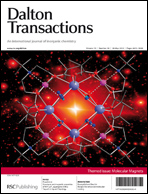Homo- and heterometallic octanuclear complexes of formula Na2{[Cu2(mpba)3][Cu(Me5dien)]6}(ClO4)6·12H2O (1), Na2{[Cu2(Mempba)3][Cu(Me5dien)]6}(ClO4)6·12H2O (2), Na2{[Ni2(mpba)3][Cu(Me5dien)]6}(ClO4)6·12H2O (3), Na2{[Ni2(Mempba)3][Cu(Me5dien)]6}(ClO4)6·9H2O (4), {[Ni2(mpba)3][Ni(dipn)(H2O)]6}(ClO4)4·12.5H2O (5), and {[Ni2(Mempba)3][Ni(dipn)(H2O)]6}(ClO4)4·12H2O (6) [mpba = 1,3-phenylenebis(oxamate), Mempba = 4-methyl-1,3-phenylenebis(oxamate), Me5dien = N,N,N′,N′′,N′′-pentamethyldiethylenetriamine, and dipn = dipropylenetriamine] have been synthesized through the “complex-as-ligand/complex-as-metal” strategy. Single-crystal X-ray diffraction analyses of 1, 3, and 5 show cationic MII2M′II6 entities (M, M′ = Cu and Ni) with an overall double-star architecture, which is made up of two oxamato-bridged MIIM′II3 star units connected through three meta-phenylenediamidate bridges between the two central metal atoms leading to a binuclear metallacryptand core of the meso-helicate-type. Dc magnetic susceptibility data for 1–6 in the temperature range 2–300 K have been analyzed through a “dimer-of-tetramers” model [H = −J(S1A·S3A + S1A·S4A + S1A·S5A + S2B·S6B + S2B·S7B + S2B·S8B) −J′S1A·S2B, with S1A = S2B = SM and S3A = S4A = S5A = S6B = S7B = S8B = SM′]. The moderate to strong antiferromagnetic coupling between the MII and M′II ions through the oxamate bridge in 1–6 (−JCu–Cu = 52.0–57.0 cm−1, −JNi–Cu = 39.1–44.7 cm−1, and −JNi–Ni = 26.3–26.6 cm−1) leads to a non-compensation of the ground spin state for the tetranuclear MIIM′II3 star units [SA = SB = 3SM′−SM = 1 (1 and 2), 1/2 (3 and 4), and 2 (5 and 6)]. Within the binuclear MII2meso-helicate cores of 1–4, a moderate to weak antiferromagnetic coupling between the MII ions (−J′Cu–Cu = 28.0–48.0 cm−1 and −J′Ni–Ni = 0.16–0.97 cm−1) is mediated by the triple m-phenylenediamidate bridge to give a ground spin singlet (S = SA−SB = 0) state for the octanuclear MII2CuII6 molecule. Instead, a weak ferromagnetic coupling between the NiII ions (J′Ni–Ni = 2.07–3.06 cm−1) operates in the binuclear NiII2meso-helicate core of 5 and 6 leading thus to a ground spin nonet (S = SA + SB = 4) state for the octanuclear NiII8 molecule. Dc magnetization data for 5 reveal a small but non-negligible axial magnetic anisotropy (D = −0.23 cm−1) of the S = 4 NiII8 ground state with an estimated value of the energy barrier for magnetization reversal of 3.7 cm−1 (U = −DS2). Ac magnetic susceptibility data for 5 show an unusual slow magnetic relaxation behaviour at low temperatures which is typical of “cluster glasses”. The temperature dependence of the relaxation time for 5 has been interpreted on the basis of the Vogel–Fulcher law for weakly interacting clusters, with values of 2.5 K, 1.4 × 10−6 s, and 4.0 cm−1 for the intermolecular interaction parameter (T0), the pre-exponential factor (τ0), and the effective energy barrier (Ueff), respectively.


 Please wait while we load your content...
Please wait while we load your content...